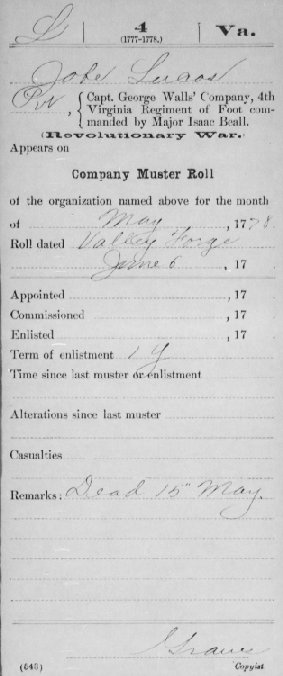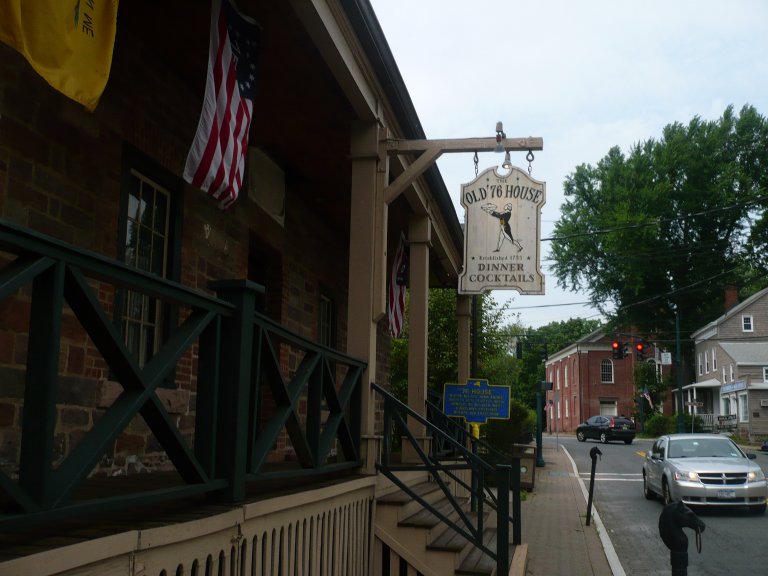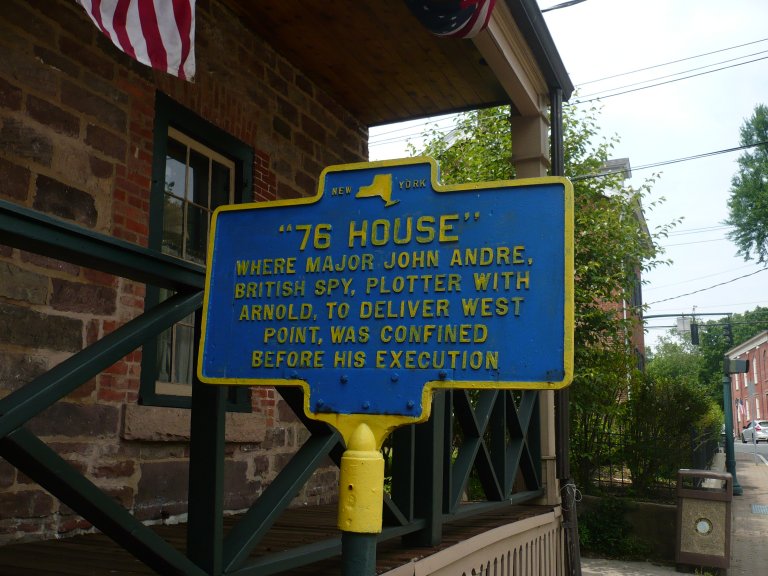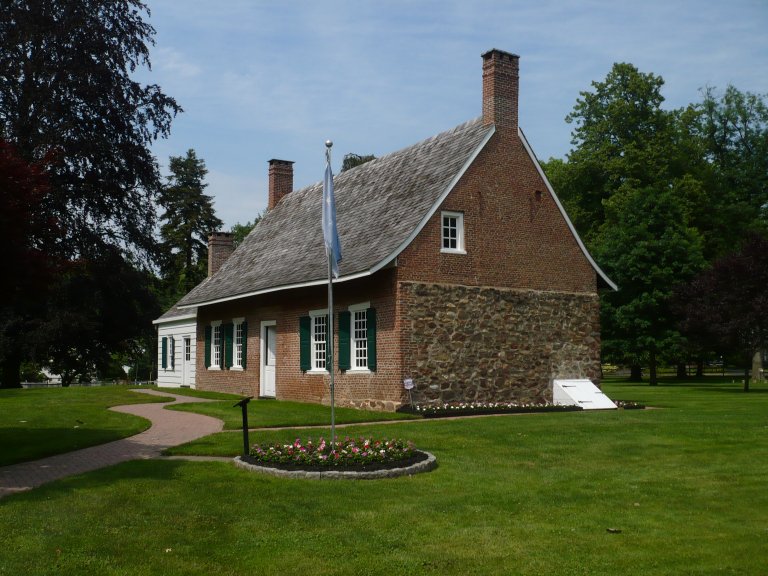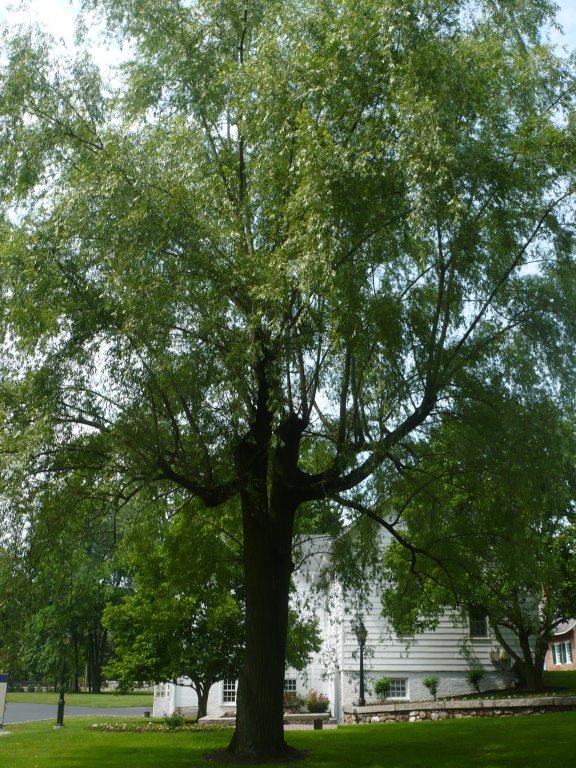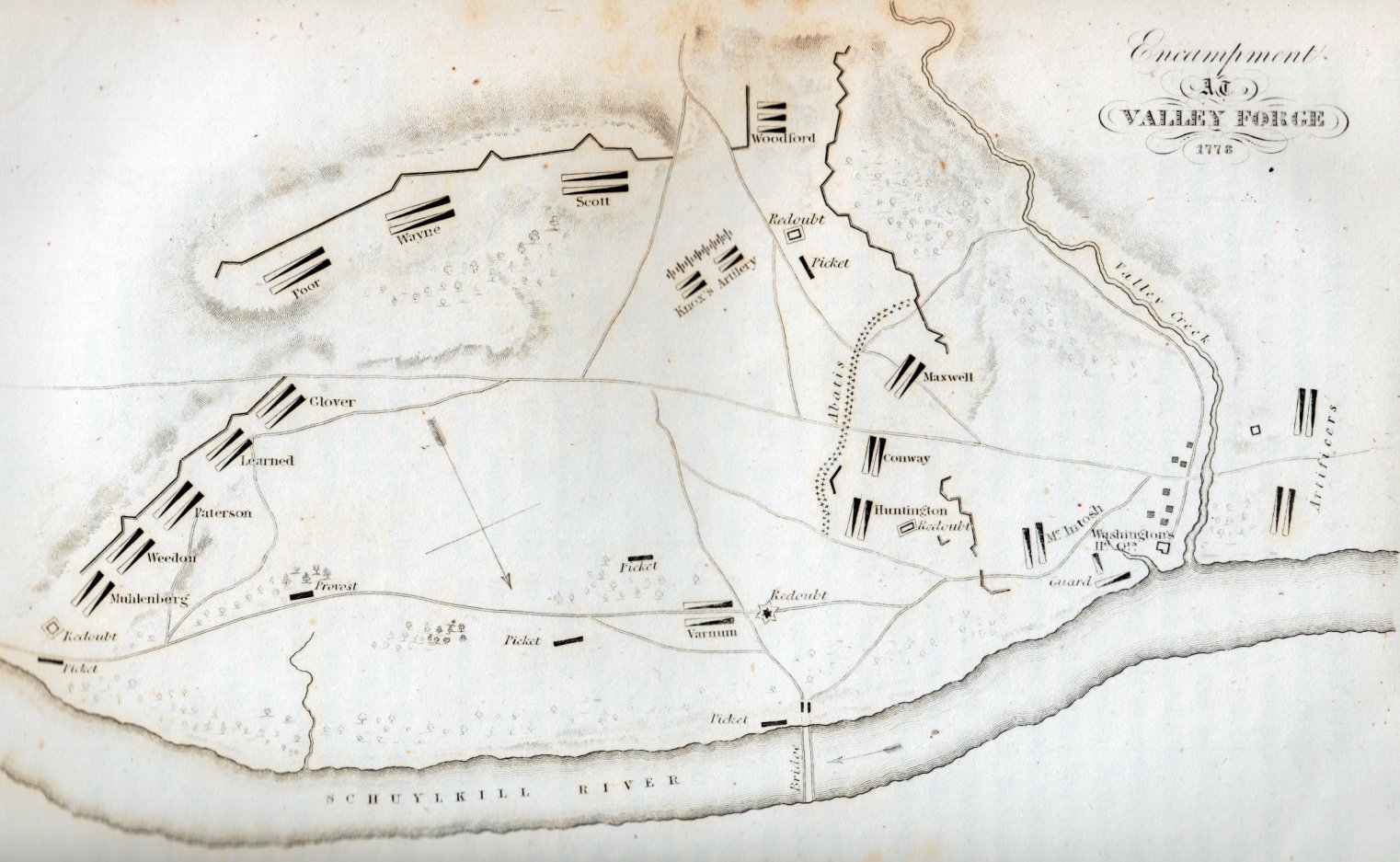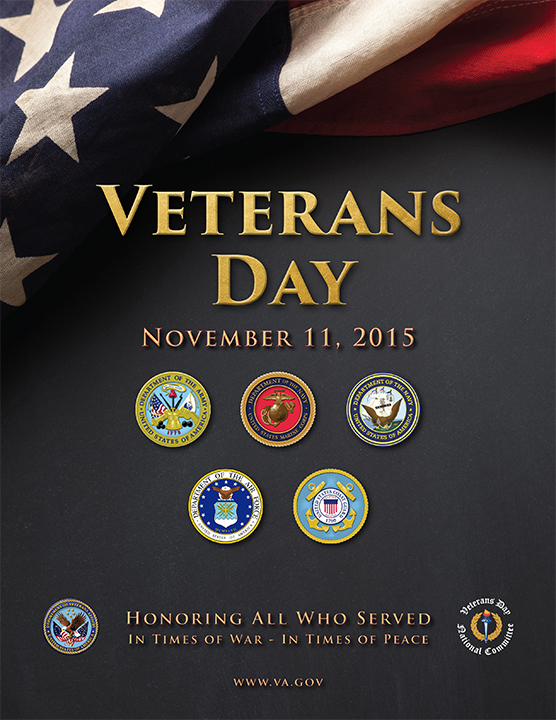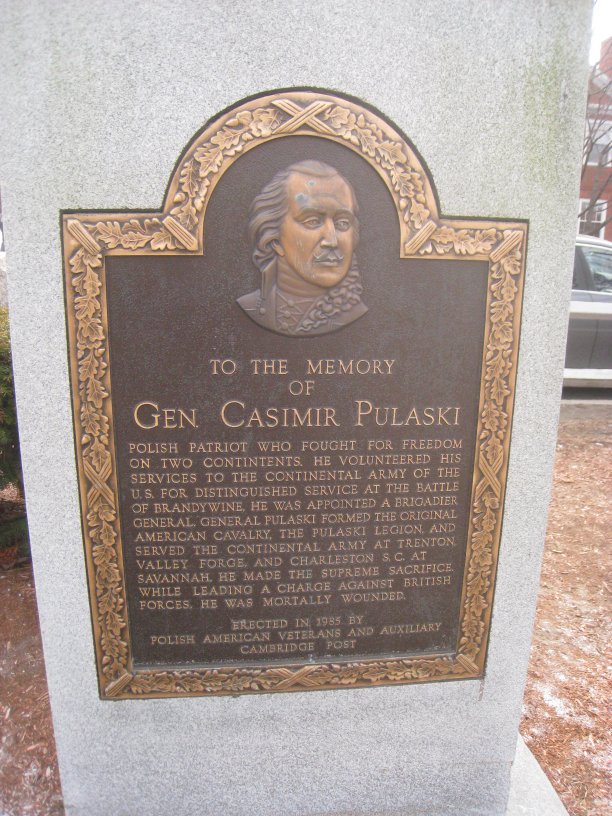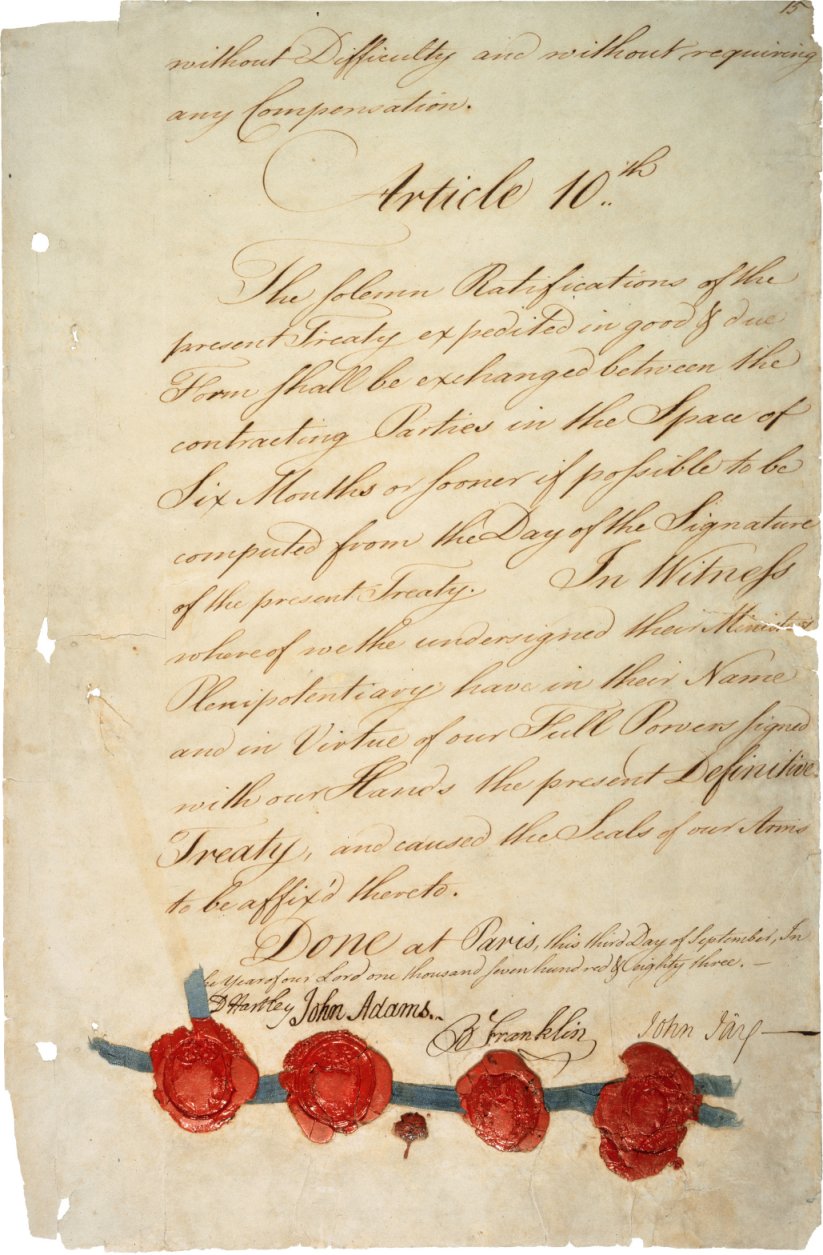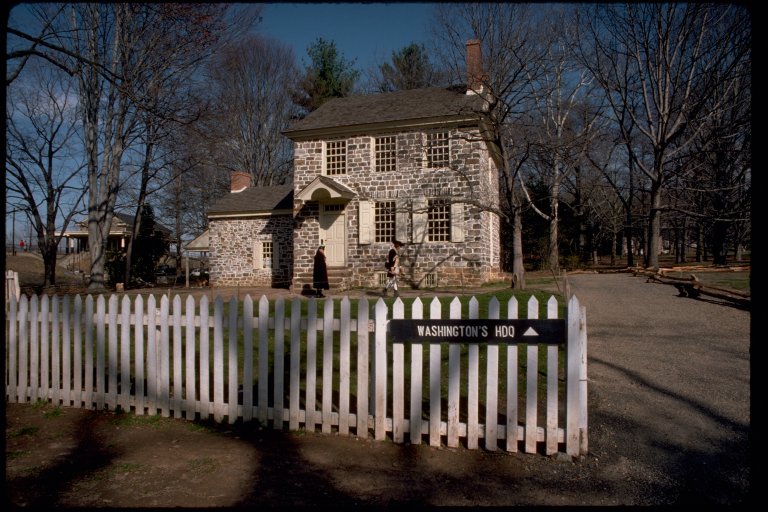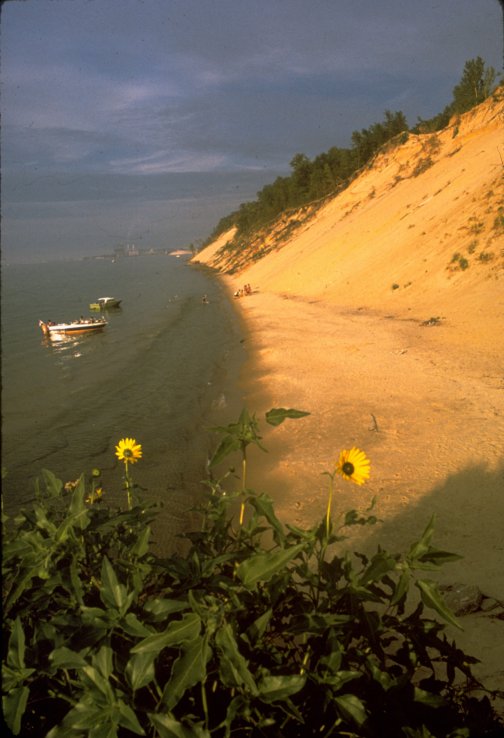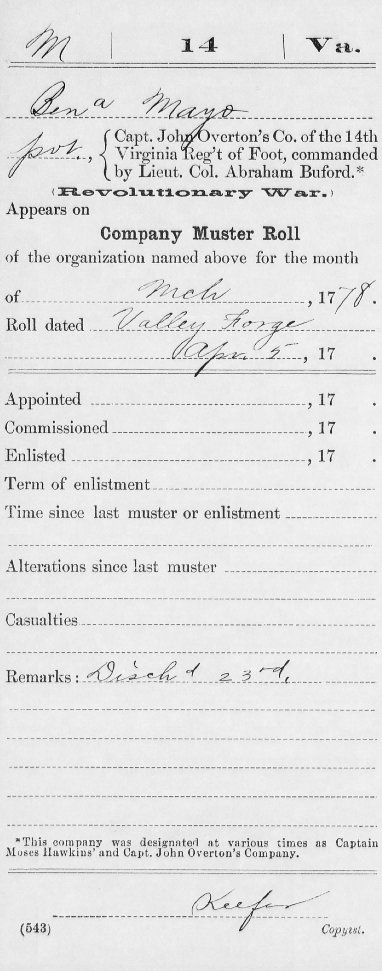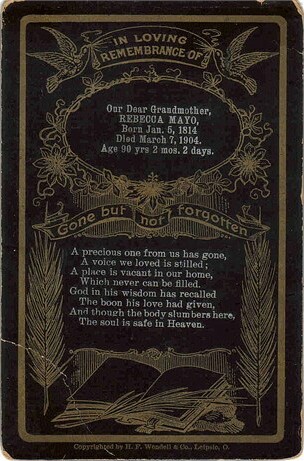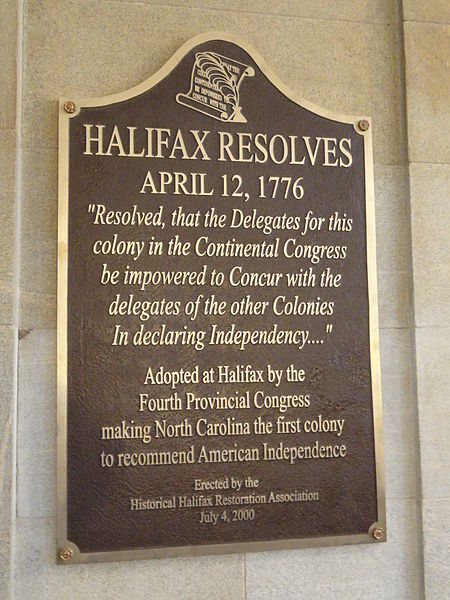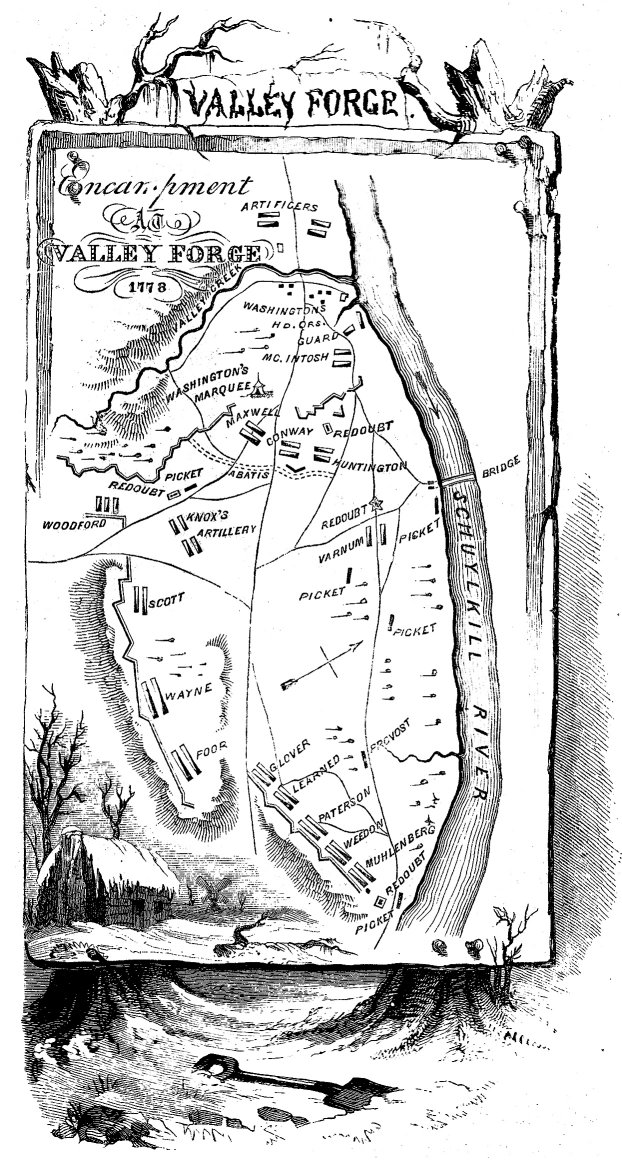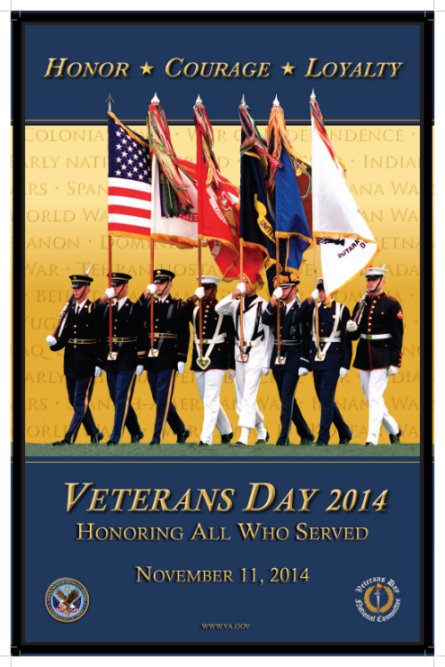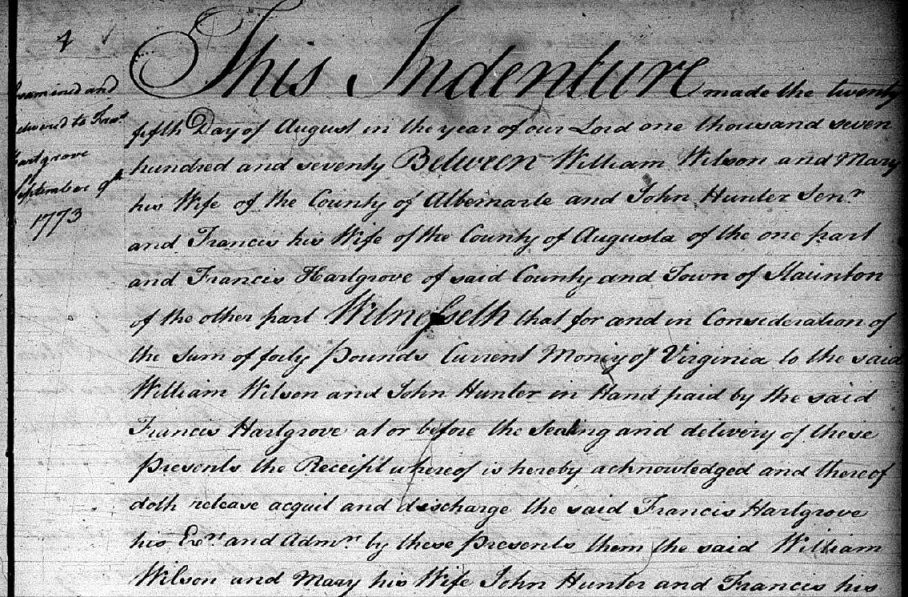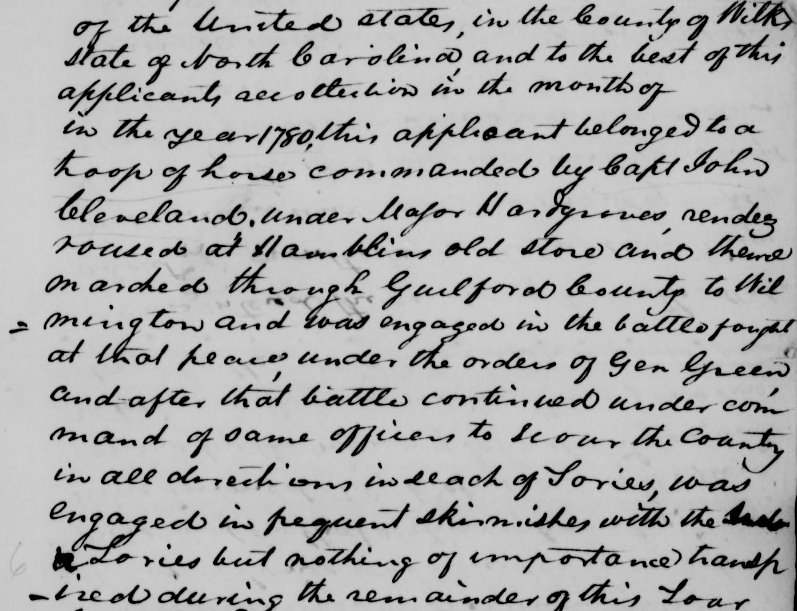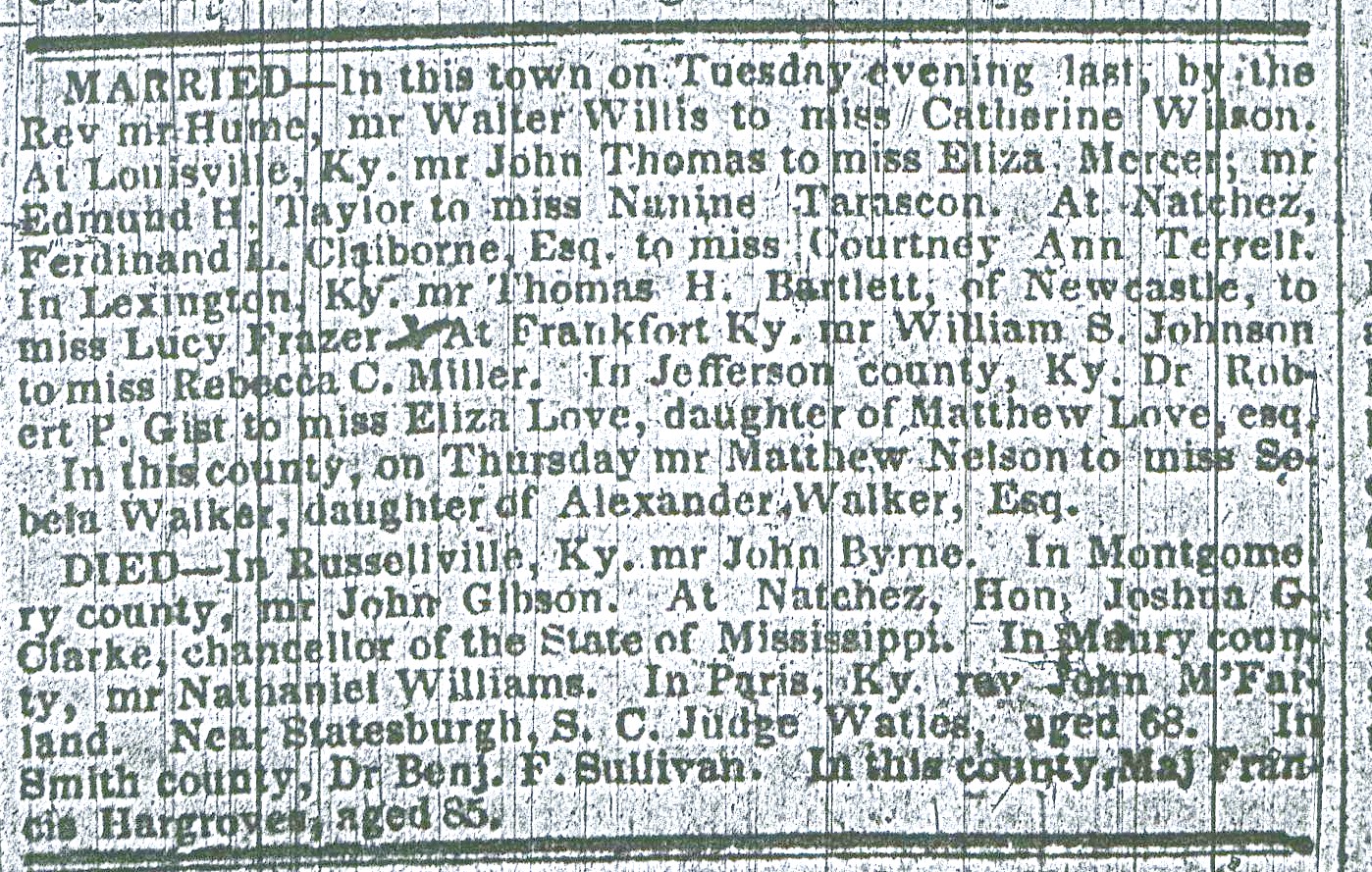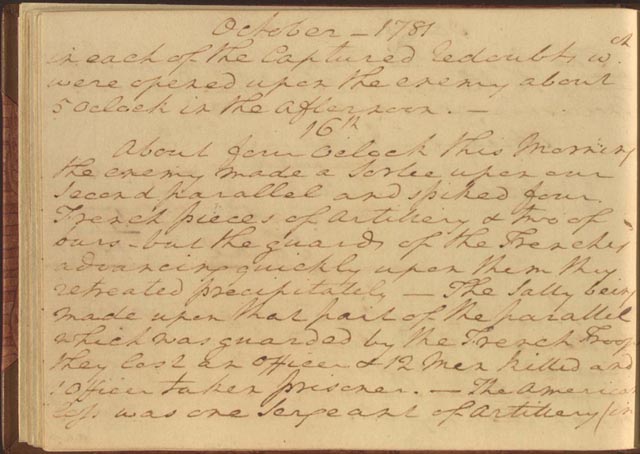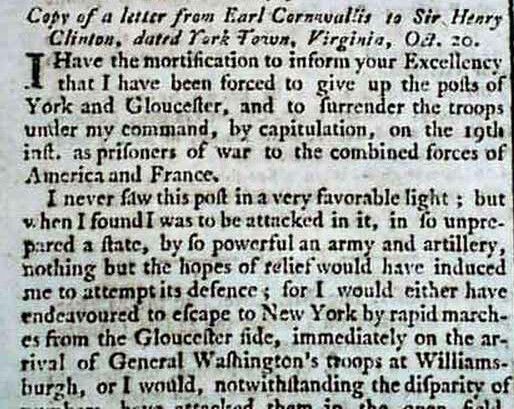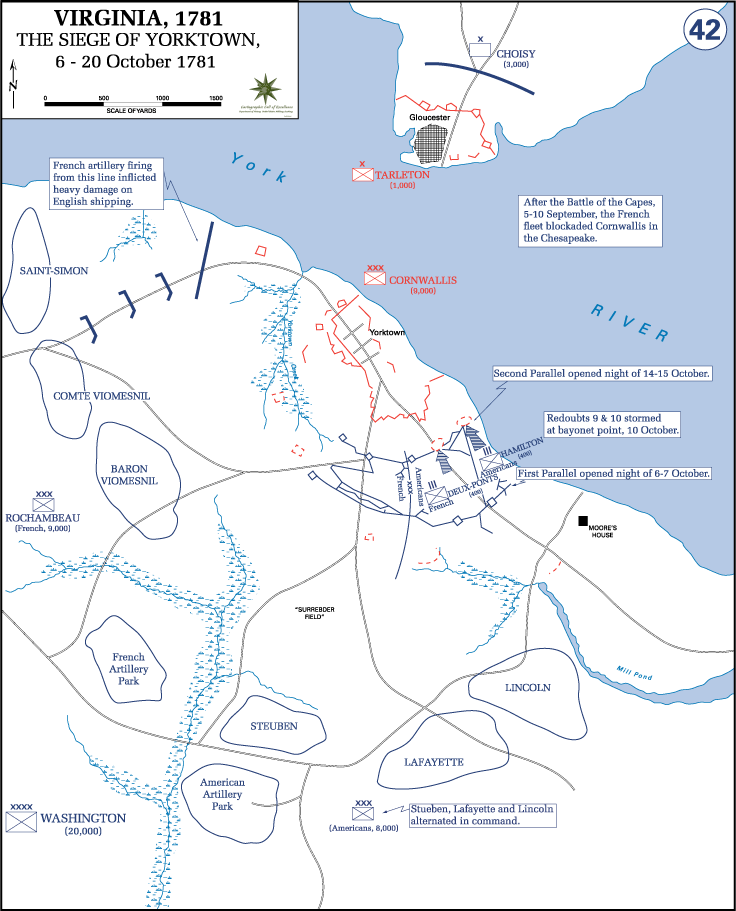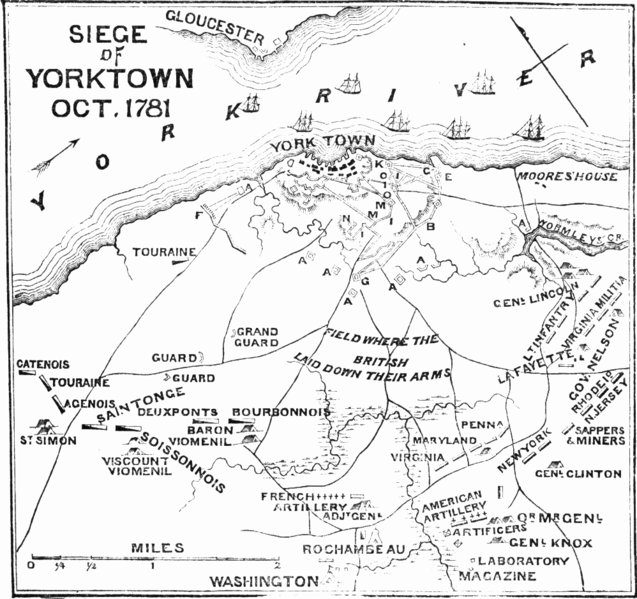Job Lucas was born 259 years ago today, on 2 November 1757 in Virginia. He was the son of my 7th-great-grandparents Edward Lucas and Elizabeth Corn.
From May 1776 to October 1777, he served as a private in the 8th Virginia Regiment. He was a waggoner.
Compiled Service Records of Soldiers who Served in the American Army during the Revolutionary War, 1775-1783. NARA microfilm publication M881, roll 1047. Virginia, Eighth Regiment. The National Archives at Washington, D.C. Available from Fold3.
In 1778, he served as a private in the 4th Virginia Regiment. He died at Valley Forge, Pennsylvania on 15 May 1778.
Compiled Service Records of Soldiers who Served in the American Army during the Revolutionary War, 1775-1783. NARA microfilm publication M881, roll 975. Virginia, Fourth Regiment. The National Archives at Washington, D.C. Available from Fold3.
According to family Bible records, the cause of death was smallpox.
Covering genealogy, family history, historical events and places, and anything else related!
Showing posts with label Revolutionary War. Show all posts
Showing posts with label Revolutionary War. Show all posts
Wednesday, November 2, 2016
Saturday, June 11, 2016
Tappan, New York
Today I visited Tappan, Rockland County, New York. I had lunch at the '76 House, the oldest tavern in New York. Major John André, who was a British spy and plotted with Benedict Arnold, was held prisoner at the '76 House before he was executed.
I also visited the DeWint House, the oldest surviving structure in Rockland County, New York. It was George Washington's temporary headquarters four times during the American Revolution.
The coat rack in the DeWint House is the original one that was used when George Washington visited.
The Carriage House was built in the mid-1800s.
The weeping willow tree on the grounds is a shoot from the largest weeping willow tree in the United States.
I also visited the DeWint House, the oldest surviving structure in Rockland County, New York. It was George Washington's temporary headquarters four times during the American Revolution.
The coat rack in the DeWint House is the original one that was used when George Washington visited.
The Carriage House was built in the mid-1800s.
The weeping willow tree on the grounds is a shoot from the largest weeping willow tree in the United States.
Monday, February 22, 2016
Military Monday: Encampment at Valley Forge
Encampment at Valley Forge, 1778. Steel engraving by George W. Boynton, 1830. In Sparkes, Jared. The Life of George Washington. Boston: Tappen & Dennet, 1843. Available from https://en.wikipedia.org/wiki/File:Encampment_at_Valley_Forge_1778.jpg
Since today is George Washington's birthday, it seemed an appropriate time to post this map of the encampment at Valley Forge, 1778. My 5th-great-grandfather Stephen Mayo and his brother Benjamin Mayo were at Valley Forge with George Washington. The Mayo brothers were in the 14th Virginia Regiment, which was part of Weedon's Brigade. Their encampment is shown on the lower left side of the map, second from the bottom. Washington was located on the other side of the encampment.
Since today is George Washington's birthday, it seemed an appropriate time to post this map of the encampment at Valley Forge, 1778. My 5th-great-grandfather Stephen Mayo and his brother Benjamin Mayo were at Valley Forge with George Washington. The Mayo brothers were in the 14th Virginia Regiment, which was part of Weedon's Brigade. Their encampment is shown on the lower left side of the map, second from the bottom. Washington was located on the other side of the encampment.
Saturday, December 12, 2015
The Hermitage
Today I visited the Hermitage in Ho-Ho-Kus, Bergen County, New Jersey. The house was named a National Historic Landmark because of its Gothic Revival architecture. It was added to the National Register of Historic Places in 1970, and to the New Jersey Register of Historic Places in 1971.
The home was originally purchased by Ann Bartow DeVisme in 1767. She and her five children moved from Manhattan to Ho-Ho-Kus. Her daughter Theodosia Bartow had married James Marcus (or Jacques Marcus) Prevost in 1763, and the couple lived in another house on the property. During the Revolutionary War, Prevost was away fighting in the British Army. Theodosia remained at the Hermitage with her family.
George Washington and his troops stayed on the grounds of the Hermitage from July 10-14, 1778, at Theodosia's invitation. Other visitors to the Hermitage included Alexander Hamilton, James Monroe, the Marquis de Lafayette, and Aaron Burr.
James Marcus Prevost died in Jamaica in 1781. In July 1782, Theodosia married Aaron Burr at the Hermitage.
In 1807, Dr. Elijah Rosegrant (Rosencrantz) purchased the Hermitage and built a cotton mill on the property. In 1847, he had architect William Rantlett construct a Victorian house which incorporated the original home. The house was remodeled in the Gothic Revival stylr, and additional wings were added.
The house remained in the Rosencrantz family for four generations. In 1970, Mary Elizabeth Rosenkrantz willed the Hermitage to the State of New Jersey. It is now a house museum.
References
The Hermitage (Ho-Ho-Kus, New Jersey)
The Hermitage Museum
Jacques Marcus Prevost
Wednesday, November 11, 2015
Veterans Day
Available from Veterans Day Poster Gallery, U.S. Department of Veterans Affairs, Office of Public and Intergovernmental Affairs.
On Veterans Day, I would once again like to thank the members of my family that have served in the United States military, or served allied nations in World War I. In addition to ancestors, this list includes uncles, cousins, and relatives by marriage.
Revolutionary War
Adam Binkley
Frederick Binkley
Abraham Louis DeMoss
Elisha Garland
Lazarus Gatlin
Jesse Greer
Francis Hardgrave
Benjamin Isbell
Henry Isbell
Thomas Isbell
Benjamin Mayo
James Mayo
Joseph Mayo
Stephen Mayo
War of 1812
Chapman Gordon
Francis Hardgrave
Skelton Hardgrave
Elias L. Mayo
Thomas Mayo
Andrew Russell
Mexican War
James Thomas Gilliam
Thomas E. Gilliam
James Hardgraves
Robert Francis Hardgraves
Thomas Tarkington
Civil War (Union)
Davidson Binkley
Samuel August Samuelson
Hugh Winters
World War I
John Joseph Berberick
John G. Leech
Ferdinand Constand Schneider
Cornelius Thomas de Kam (Canada)
Edward Otto Troedson (Australia)
George Arthur Troedson (Australia)
World War II
Gilbert Joseph Blocker
Theodore Boe
David Theodore Borg
Delmar Emil Borg
Walton E. Borg
Clifford Irwin Clark
Louis D. Hightower
William Philip Carl Illig
Norman Kowelman
James Bratton Lampley
Harry Ashby Lee
William Patterson Leech
Leroy N. Mayrant
Julian G. Nagle
Amanda Mary (Whitman) Pybas
Earl Mason Roberts
William Robert Ruty
Karl J. Schneider
Fred Logan Trickey
Korean War
Harry Ashby Lee
Other Veterans
Nile Weldon Farnsworth, United States Navy, 1946-1949
John Joseph Koestler, United States Army 1958-1964
Frank Casole, United States Army 1977-1981
Todd Thompson, United States Air Force 1991-2011
Current Service Members
Jon Rodriguez, United States Marines
Mitchell Stansbury, United States Navy
On Veterans Day, I would once again like to thank the members of my family that have served in the United States military, or served allied nations in World War I. In addition to ancestors, this list includes uncles, cousins, and relatives by marriage.
Revolutionary War
Adam Binkley
Frederick Binkley
Abraham Louis DeMoss
Elisha Garland
Lazarus Gatlin
Jesse Greer
Francis Hardgrave
Benjamin Isbell
Henry Isbell
Thomas Isbell
Benjamin Mayo
James Mayo
Joseph Mayo
Stephen Mayo
War of 1812
Chapman Gordon
Francis Hardgrave
Skelton Hardgrave
Elias L. Mayo
Thomas Mayo
Andrew Russell
Mexican War
James Thomas Gilliam
Thomas E. Gilliam
James Hardgraves
Robert Francis Hardgraves
Thomas Tarkington
Civil War (Union)
Davidson Binkley
Samuel August Samuelson
Hugh Winters
World War I
John Joseph Berberick
John G. Leech
Ferdinand Constand Schneider
Cornelius Thomas de Kam (Canada)
Edward Otto Troedson (Australia)
George Arthur Troedson (Australia)
World War II
Gilbert Joseph Blocker
Theodore Boe
David Theodore Borg
Delmar Emil Borg
Walton E. Borg
Clifford Irwin Clark
Louis D. Hightower
William Philip Carl Illig
Norman Kowelman
James Bratton Lampley
Harry Ashby Lee
William Patterson Leech
Leroy N. Mayrant
Julian G. Nagle
Amanda Mary (Whitman) Pybas
Earl Mason Roberts
William Robert Ruty
Karl J. Schneider
Fred Logan Trickey
Korean War
Harry Ashby Lee
Other Veterans
Nile Weldon Farnsworth, United States Navy, 1946-1949
John Joseph Koestler, United States Army 1958-1964
Frank Casole, United States Army 1977-1981
Todd Thompson, United States Air Force 1991-2011
Current Service Members
Jon Rodriguez, United States Marines
Mitchell Stansbury, United States Navy
Sunday, October 11, 2015
General Pulaski Memorial Day
General Casimir Pulaski plaque, Cambridge Commons, Cambridge, Massachusetts. Photo by Daderot (Own work) [Public domain], 14 February 2010. Available from Wikimedia Commons.
October 11 is General Pulaski Memorial Day, in honor of Casimir (Kazimierz) Pulaski. In 1929, Congress passed a resolution designating October 11 as General Pulaski Memorial Day. Since 1931, a presidential proclamation has been issued for the holiday every year.
Kazimierz Michał Władysław Wiktor Pułaski was born on 6 March 1745 in Warsaw, Poland. He and his father Józef Pulaski were among the founders of the Bar Confederation, an association formed to defend Poland against Russia and King Stanisław August Poniatowski. Pulaski became the commander after his father died in 1769. One of his military accomplishments was taking control of the Jasna Góra Monastery in September 1770. In 1771 members of the Bar Confederation attempted to kidnap King Stanisław August Poniatowski, and Pulaski was implicated. He went to Silesia, Prussia in 1772 and met with Franciszka Corvin-Krasińska, the wife of Charles of Saxony, Duke of Courland. He went to France in 1773, and attempted to join the French Army, but was unsuccessful. He spent some time in a debtors' prison in 1775. He met Benjamin Franklin in 1777. Franklin and the Marquis de Lafayette recruited him for service in the Continental Army.
On 23 July 1777, Pulaski arrived in Marblehead, Massachusetts. He traveled to Pennsylvania in August, and met George Washington. His first battle in North America was the Battle of Brandywine on 11 September 1777. Pulaski gathered troops together and charged in order to prevent the British from retreating. On 15 September 1777, Washington made Pulaski a brigadier general in the Continental Army cavalry.
Pulaski participated in the Battle of Germantown, and spent the winter of 1777-1778 at Valley Forge. He assisted General Anthony Wayne in February 1778, but returned to Valley Forge in March.
Pulaski created a new cavalry regiment, Pulaski's Legion. Its headquarters were in Baltimore, Maryland, and most of the men were recruited there.They participated in the Little Egg Harbor Massacre on 15 October 1778.
On 8 May 1779, Pulaski arrived in Charleston, South Carolina.In September, he headed to Georgia. Pulaski's regiment served as advance guard for Admiral Charles Hector, comte d'Estaing's troops. Pulaski commanded both the French and American cavalry on 9 October 1779 at the Siege of Savannah. He was wounded by grapeshot and carried off the battlefield. He died on 11 or 15 October 1779.
My 5th-great-grandfather Stephen Mayo also participated in the battles of Brandywine and Germantown. He and his brother Benjamin were at Valley Forge together.
Pulaski County, Kentucky is named for Casimir Pulaski. My 5th-great-grandparents Andrew and Hannah (Hardgrave) Russell lived in Pulaski County, Kentucky, and my 4th-great-grandmother Sobrina Russell was probably born there.
References
Bar Confederation
Casimir Pulaski
Casimir Pulaski, Father of the U.S. Cavalry
A Chronology of Casimir Pulaski's Life 1745-1779
General Casimir Pulaski (1745-1779)
General Pulaski Memorial Day
October 11 is General Pulaski Memorial Day, in honor of Casimir (Kazimierz) Pulaski. In 1929, Congress passed a resolution designating October 11 as General Pulaski Memorial Day. Since 1931, a presidential proclamation has been issued for the holiday every year.
Kazimierz Michał Władysław Wiktor Pułaski was born on 6 March 1745 in Warsaw, Poland. He and his father Józef Pulaski were among the founders of the Bar Confederation, an association formed to defend Poland against Russia and King Stanisław August Poniatowski. Pulaski became the commander after his father died in 1769. One of his military accomplishments was taking control of the Jasna Góra Monastery in September 1770. In 1771 members of the Bar Confederation attempted to kidnap King Stanisław August Poniatowski, and Pulaski was implicated. He went to Silesia, Prussia in 1772 and met with Franciszka Corvin-Krasińska, the wife of Charles of Saxony, Duke of Courland. He went to France in 1773, and attempted to join the French Army, but was unsuccessful. He spent some time in a debtors' prison in 1775. He met Benjamin Franklin in 1777. Franklin and the Marquis de Lafayette recruited him for service in the Continental Army.
On 23 July 1777, Pulaski arrived in Marblehead, Massachusetts. He traveled to Pennsylvania in August, and met George Washington. His first battle in North America was the Battle of Brandywine on 11 September 1777. Pulaski gathered troops together and charged in order to prevent the British from retreating. On 15 September 1777, Washington made Pulaski a brigadier general in the Continental Army cavalry.
Pulaski participated in the Battle of Germantown, and spent the winter of 1777-1778 at Valley Forge. He assisted General Anthony Wayne in February 1778, but returned to Valley Forge in March.
Pulaski created a new cavalry regiment, Pulaski's Legion. Its headquarters were in Baltimore, Maryland, and most of the men were recruited there.They participated in the Little Egg Harbor Massacre on 15 October 1778.
On 8 May 1779, Pulaski arrived in Charleston, South Carolina.In September, he headed to Georgia. Pulaski's regiment served as advance guard for Admiral Charles Hector, comte d'Estaing's troops. Pulaski commanded both the French and American cavalry on 9 October 1779 at the Siege of Savannah. He was wounded by grapeshot and carried off the battlefield. He died on 11 or 15 October 1779.
My 5th-great-grandfather Stephen Mayo also participated in the battles of Brandywine and Germantown. He and his brother Benjamin were at Valley Forge together.
Pulaski County, Kentucky is named for Casimir Pulaski. My 5th-great-grandparents Andrew and Hannah (Hardgrave) Russell lived in Pulaski County, Kentucky, and my 4th-great-grandmother Sobrina Russell was probably born there.
References
Bar Confederation
Casimir Pulaski
Casimir Pulaski, Father of the U.S. Cavalry
A Chronology of Casimir Pulaski's Life 1745-1779
General Casimir Pulaski (1745-1779)
General Pulaski Memorial Day
Thursday, September 3, 2015
Treaty of Paris Signed
Last page of the Treaty of Paris, 1783. Our Documents. Also available from Wikimedia Commons.
23 years ago today, the Treaty of Paris was signed, and the Revolutionary War ended.
The Continental Congress appointed a commission to negotiate a peace treaty with Great Britain, and in April 1782, negotiations began in Paris, France. John Adams, Benjamin Franklin, and John Jay represented the United States. David Hartley and Richard Oswald represented Great Britain. Henry Laurens joined Adams, Franklin, and Jay in November 1782.
The treaty was signed at the Hotel d'York in Paris on 3 September 1783 by Hartley, Adams, Franklin, and Jay. It consisted of ten articles.
Article 1 - acknowledged that the former colonies were free and independent states
Article 2 - established the boundaries between the United States and British North America
Article 3 - granted the people of the United States the right to fish on the Grand Banks and other banks of Newfoundland and in the Gulf of Saint Lawrence
Article 4 - creditors on both sides should be paid
Article 5 - Congress was to recommend that state legislatures provide for the restitution of property belonging to Loyalists
Article 6 - no more property belonging to Loyalists was to be confiscated
Article 7 - prisoners of were on both sides were to be released, and the British army was not to take any property, including slaves
Article 8 - Great Britain and the United States were both to have access to the Mississippi River
Article 9 - any territory conquered by the United States or Great Britain before the arrival of the preliminary articles of peace was to be returned
Article 10 - the treaty was to be ratified within six months
References
Our Documents: Treaty of Paris
Primary Documents in American History: Treaty of Paris
Treaty of Paris - American Revolution
Treaty of Paris (1783)
Treaty of Paris 1783
Tuesday, August 25, 2015
Founders' Day, the Birthday of the National Park Service
On 25 August 1916, President Woodrow Wilson signed the act that established the National Park Service. Every year on August 25, the National Park Service celebrates Founders Day.
My parents have visited some of the national parks, including Yellowstone National Park and Yosemite National Park.
I took this picture at one of the newest national parks, the Paterson Great Falls National Historical Park.
Some places where my ancestors spent time are now national historical parks. My 5th-great-grandfather Stephen Mayo and his brother Benjamin camped at Valley Forge during the revolutionary War. My 5th-great-grandmother Hannah Hardgrave and her parents, my 6th-great-grandparents Francis Hardgrave and Sarah Greer, passed through the Cumberland Gap when they traveled from Wilkes County, North Carolina to Kentucky.
My parents have visited some of the national parks, including Yellowstone National Park and Yosemite National Park.
I took this picture at one of the newest national parks, the Paterson Great Falls National Historical Park.
Paterson Great Falls National Historical Park
Some places where my ancestors spent time are now national historical parks. My 5th-great-grandfather Stephen Mayo and his brother Benjamin camped at Valley Forge during the revolutionary War. My 5th-great-grandmother Hannah Hardgrave and her parents, my 6th-great-grandparents Francis Hardgrave and Sarah Greer, passed through the Cumberland Gap when they traveled from Wilkes County, North Carolina to Kentucky.
Valley Forge National Historical Park. Photo from the National Park Service.
Cumberland Gap National Historical Park. Photo from the National Park Service.
Chellberg Farm is now part of the Indiana Dunes National Lakeshore. My 2nd-great-grandmother's brother Alfred Borg married Emily Kjellberg, and they lived at Chellberg Farm.
1885 brick house on Chellberg Farm. Photo by Chris Light at en.wikipedia [CC BY-SA 3.0 (http://creativecommons.org/licenses/by-sa/3.0) or GFDL (http://www.gnu.org/copyleft/fdl.html)]. Available from Wikimedia Commons.
Indiana Dunes National Lakeshore. Photo from the National Park Service.
Saturday, July 4, 2015
Sibling Saturday: Mayo Brothers in the Revolutionary War
My 5th-great-grandfather Stephen Mayo was a private in the Revolutionary War. He was a minuteman in Captain Thompson's company under Major Campbell, a private in Captain Moses Hawkins'/Capt. John Overton's company, Colonel Charles Lewis' 14th Virginia regiment, a private in Captain Hatcher's Virginia company, and a private in Captain Anthony Hayden's Virginia company.
Stephen Mayo compiled service record. Compiled Service Records of Soldiers who Served in the American Army during the Revolutionary War, 1775-1783. NARA microfilm publication M881, roll 1081. Virginia, Fourteenth Regiment. The National Archives at Washington, D.C.Available from Fold3.
Stephen's brother Benjamin was also in the 14th Virginia regiment. They were at Valley Forge together.
Benjamin Mayo compiled service record. Compiled Service Records of Soldiers who Served in the American Army during the Revolutionary War, 1775-1783. NARA microfilm publication M881, roll 1081. Virginia, Fourteenth Regiment. The National Archives at Washington, D.C.Available from Fold3.
Their brother Joseph was a 2nd lieutenant in the Fluvanna County, Virginia Militia.
McAllister, J. T. Virginia Militia in the Revolutionary War: McAllister's Data. Hot Springs, Virginia: McAllister Publishing, 1913. Page 23. Available from Internet Archive.
Their brother James was in the Albemarle County, Virginia Militia. Their half-brother Valentine Mayo was a private in the Continental Troops. Other Mayo brothers may have served as well.
Stephen Mayo compiled service record. Compiled Service Records of Soldiers who Served in the American Army during the Revolutionary War, 1775-1783. NARA microfilm publication M881, roll 1081. Virginia, Fourteenth Regiment. The National Archives at Washington, D.C.Available from Fold3.
Stephen's brother Benjamin was also in the 14th Virginia regiment. They were at Valley Forge together.
Benjamin Mayo compiled service record. Compiled Service Records of Soldiers who Served in the American Army during the Revolutionary War, 1775-1783. NARA microfilm publication M881, roll 1081. Virginia, Fourteenth Regiment. The National Archives at Washington, D.C.Available from Fold3.
Their brother Joseph was a 2nd lieutenant in the Fluvanna County, Virginia Militia.
McAllister, J. T. Virginia Militia in the Revolutionary War: McAllister's Data. Hot Springs, Virginia: McAllister Publishing, 1913. Page 23. Available from Internet Archive.
Their brother James was in the Albemarle County, Virginia Militia. Their half-brother Valentine Mayo was a private in the Continental Troops. Other Mayo brothers may have served as well.
Friday, July 3, 2015
Funeral Card Friday: Rebecca (Dawson) Mayo
Image from shamurah on Ancestry.com
Rebecca Dawson was born in Virginia on 5 January 1814. On 24 November 1834, she married my 5th-great-grandfather Stephen Mayo. They had a daughter, Martha. Stephen died on 16 March 1847. By 1850, Rebecca lived with her daughter in Newbern, Pulaski County, Virginia. She died on 7 March 1904. She was the second to last surviving Revolutionary War widow.
Sunday, April 12, 2015
Halifax Resolves
Halifax Resolves plaque, North Carolina State Capitol, Raleigh, North Carolina. Photo by Daderot [Public domain], 5 October 2011. Available from Wikimedia Commons.
On 12 April 1776, the Fourth North Carolina Provincial Congress authorized North Carolina's delegates to the Second Continental Congress (Joseph Hewes, William Hooper, and John Penn) to vote for independence. This action was the first to call for independence. It was directed to all the colonies and their delegates at the Continental Congress. Because the Fourth Provincial Congress met in Halifax, North Carolina, the action became known as the Halifax Resolves.
References
Halifax Resolves
The Halifax Resolves (North Carolina History: A Digital Textbook)
Halifax Resolves (North Carolina Manual)
Historic Halifax: Halifax and the Revolution
North Carolina Advocates Independence
On 12 April 1776, the Fourth North Carolina Provincial Congress authorized North Carolina's delegates to the Second Continental Congress (Joseph Hewes, William Hooper, and John Penn) to vote for independence. This action was the first to call for independence. It was directed to all the colonies and their delegates at the Continental Congress. Because the Fourth Provincial Congress met in Halifax, North Carolina, the action became known as the Halifax Resolves.
References
Halifax Resolves
The Halifax Resolves (North Carolina History: A Digital Textbook)
Halifax Resolves (North Carolina Manual)
Historic Halifax: Halifax and the Revolution
North Carolina Advocates Independence
Friday, December 19, 2014
Continental Army Enters Valley Forge
The Encampment at Valley Forge, PA. Lossing, Benson John. Field Book of the Revolution. Vol. 2. New York: Harper Brothers, 1855. Page 128. Available from Wikipedia.
On 19 December 1777, George Washington and his Continental Army entered their winter quarters at Valley Forge, Pennsylvania. 12,000 men marched in from their encampment at White Marsh (now Fort Washington State Park). They began constructing huts; the first one was completed in three days.
By the end of the winter, more than 2,500 soldiers had died from diseases such as dysentery, influenza, pneumonia, typhoid fever, typhus, and smallpox.
My 5th-great-grandfather Stephen Mayo was at Valley Forge. He was in Weedon's Brigade, 14th Virginia Regiment.The muster roll shows that he was sick in the winter. Fortunately, he survived. 163 men from his brigade died at Valley Forge.
Every December 19 at Valley Forge National Historical Park, there is a march in to commemorate the arrival of the Continental Army.
References
Annual March In of the Continental Army Commemoration
Continental Army enters winter camp at Valley Forge
The Encampment
History & Culture - Valley Forge National Historical Park
Valley Forge
Valley Forge Legacy: The Muster Roll Project
Washington leads troops into winter quarters at Valley Forge
On 19 December 1777, George Washington and his Continental Army entered their winter quarters at Valley Forge, Pennsylvania. 12,000 men marched in from their encampment at White Marsh (now Fort Washington State Park). They began constructing huts; the first one was completed in three days.
By the end of the winter, more than 2,500 soldiers had died from diseases such as dysentery, influenza, pneumonia, typhoid fever, typhus, and smallpox.
My 5th-great-grandfather Stephen Mayo was at Valley Forge. He was in Weedon's Brigade, 14th Virginia Regiment.The muster roll shows that he was sick in the winter. Fortunately, he survived. 163 men from his brigade died at Valley Forge.
Every December 19 at Valley Forge National Historical Park, there is a march in to commemorate the arrival of the Continental Army.
References
Annual March In of the Continental Army Commemoration
Continental Army enters winter camp at Valley Forge
The Encampment
History & Culture - Valley Forge National Historical Park
Valley Forge
Valley Forge Legacy: The Muster Roll Project
Washington leads troops into winter quarters at Valley Forge
Tuesday, November 11, 2014
Veterans Day
Available from Veterans Day Poster Gallery, U.S. Department of Veterans Affairs, Office of Public and Intergovernmental Affairs.
On Veterans Day, I would like to thank the members of my family that have served in the United States military, or served allied nations in World War I. In addition to ancestors, this list includes uncles, cousins, and relatives by marriage.
Revolutionary War
Adam Binkley
Frederick Binkley
Abraham Louis DeMoss
Elisha Garland
Lazarus Gatlin
Jesse Greer
Francis Hardgrave
Benjamin Isbell
Henry Isbell
Thomas Isbell
Benjamin Mayo
James Mayo
Joseph Mayo
Stephen Mayo
War of 1812
Chapman Gordon
Francis Hardgrave
Skelton Hardgrave
Elias L. Mayo
Thomas Mayo
Andrew Russell
Mexican War
James Thomas Gilliam
Thomas E. Gilliam
James Hardgraves
Robert Francis Hardgraves
Thomas Tarkington
Civil War (Union)
Davidson Binkley
Samuel August Samuelson
Hugh Winters
World War I
John Joseph Berberick
John G. Leech
Ferdinand Constand Schneider
Cornelius Thomas de Kam (Canada)
Edward Otto Troedson (Australia)
George Arthur Troedson (Australia)
World War II
Gilbert Joseph Blocker
Theodore Boe
David Theodore Borg
Delmar Emil Borg
Walton E. Borg
Clifford Irwin Clark
Louis D. Hightower
William Philip Carl Illig
Norman Kowelman
James Bratton Lampley
Harry Ashby Lee
William Patterson Leech
Leroy N. Mayrant
Julian G. Nagle
Amanda Mary (Whitman) Pybas
Earl Mason Roberts
William Robert Ruty
Karl J. Schneider
Fred Logan Trickey
Korean War
Harry Ashby Lee
Other Veterans
John Joseph Koestler, United States Army 1958-1964
Frank Casole, United States Army 1977-1981
Todd Thompson, United States Air Force 1991-2011
Current Service Members
Jon Rodriguez, United States Marines
On Veterans Day, I would like to thank the members of my family that have served in the United States military, or served allied nations in World War I. In addition to ancestors, this list includes uncles, cousins, and relatives by marriage.
Revolutionary War
Adam Binkley
Frederick Binkley
Abraham Louis DeMoss
Elisha Garland
Lazarus Gatlin
Jesse Greer
Francis Hardgrave
Benjamin Isbell
Henry Isbell
Thomas Isbell
Benjamin Mayo
James Mayo
Joseph Mayo
Stephen Mayo
War of 1812
Chapman Gordon
Francis Hardgrave
Skelton Hardgrave
Elias L. Mayo
Thomas Mayo
Andrew Russell
Mexican War
James Thomas Gilliam
Thomas E. Gilliam
James Hardgraves
Robert Francis Hardgraves
Thomas Tarkington
Civil War (Union)
Davidson Binkley
Samuel August Samuelson
Hugh Winters
World War I
John Joseph Berberick
John G. Leech
Ferdinand Constand Schneider
Cornelius Thomas de Kam (Canada)
Edward Otto Troedson (Australia)
George Arthur Troedson (Australia)
World War II
Gilbert Joseph Blocker
Theodore Boe
David Theodore Borg
Delmar Emil Borg
Walton E. Borg
Clifford Irwin Clark
Louis D. Hightower
William Philip Carl Illig
Norman Kowelman
James Bratton Lampley
Harry Ashby Lee
William Patterson Leech
Leroy N. Mayrant
Julian G. Nagle
Amanda Mary (Whitman) Pybas
Earl Mason Roberts
William Robert Ruty
Karl J. Schneider
Fred Logan Trickey
Korean War
Harry Ashby Lee
Other Veterans
John Joseph Koestler, United States Army 1958-1964
Frank Casole, United States Army 1977-1981
Todd Thompson, United States Air Force 1991-2011
Current Service Members
Jon Rodriguez, United States Marines
Saturday, November 8, 2014
52 Ancestors: #45 Francis Hardgrave, Revolutionary War Captain and Major
My 6th-great-grandfather Francis Hardgrave was born on 5 March 1745 in Augusta County, Virginia. He was the son of James Hardgrave and Elizabeth Cawley. Francis married Sarah Greer, and the couple moved to Surry County, North Carolina about 1770. They lived near Sarah's father John Greer and other members of the Greer family. Francis was tax assessor for his local tax district in 1777. The area became part of Wilkes County after the county was founded in 1778.
Francis and Sarah had nine children: James (born 12 December 1772), Sarah (born 31 December 1776), Robert (born 17 October 1778), Nancy (born 6 August 1780), my 5th-great-grandmother Hannah (born 22 February 1782), Micajah Lewis (born 1 November 1783), Seeley (born 27 April 1786, died 23 April 1791), John (born 29 October 1787), and Skelton (born 7 May 1792).
During the American Revolution, Francis was a captain in the Surry County Regiment of Militia in 1776-1777, and was a captain in the Wilkes County Regiment of Militia in 1778-1780. In 1780-1781, he was a major in the Wilkes County Militia, under Col. Benjamin Cleveland. He is known to have participated in the Cherokee Expedition (1 August 1776-1 November 1776) and in the Battle of Hanging Rock (6 August 1780).
Around 1795, Francis and his family moved Lincoln County, Kentucky. In 1799, he moved to Davidson County, Tennessee. His son James and his family also moved to Tennessee and settled in nearby Williamson County. His three daughters remained in Kentucky. His daughter Sarah had married Isaac Lowe in Wilkes County, North Carolina in 1790; they lived in Barren County, Kentucky. Nancy married Archibald Mills in Lincoln County, Kentucky in 1797, and Hannah married Andrew Russell in 1799. Both couples lived in Pulaski County, Kentucky; Nancy and Archibald then moved to Wayne County, Kentucky.
Francis was a member of the Providence Baptist Church in Davidson County, Tennessee. Although he was in his sixties, Francis served in the War of 1812.
Francis' daughters Nancy and Hannah and their families eventually came to Tennessee as well. Nancy, by then a widow, married her husband's brother John Mills in Davidson County, Tennessee in 1820, and they settled in nearby Sumner County, Tennessee. Hannah, who was head of household by 1820, lived near her parents on land that Francis owned.
Francis died on 7 August 1828 in Davidson County, Tennessee. He is buried in the Hardgrave Family Cemetery in Williamson County, Tennessee. In his will, he left his daughter Hannah, my 5th-great-grandmother, the land that she was living on, and he stated that after she died, it was to go to her son James Russell. James Russell was Hannah's youngest son, and possibly her youngest child. Hannah appears to have been widowed by 1820, when James was only about three years old. Francis made sure that his young grandson would be provided for. He also specified that after his three daughters died, their shares of the inheritance were to be divided among the heirs of their bodies. He wanted to be sure that the inheritance passed to his daughters' descendants.
Deed, 25 August 1770. Augusta County Deed Book 17, 1770-1771. Library of Virginia, microfilm reel 9. Francis Hardgrave sold his land in Staunton, Augusta County, Virginia.
Fries, Adelaide L., ed. Records of the Moravians in North Carolina. Volume IV: 1780-1783. Raleigh, NC: Edwards & Broughton, 1930. Available from Internet Archive.
Bennet Tilley pension application file. Case Files of Pension and Bounty-Land Warrant Applications Based on Revolutionary War Service. NARA microfilm publication M804. The National Archives at Washington, D.C. Available from Fold3.
Will of Francis Hardgrave, Davidson County, Tennessee, Will Book No. 9. Available from FamilySearch.
Francis and Sarah had nine children: James (born 12 December 1772), Sarah (born 31 December 1776), Robert (born 17 October 1778), Nancy (born 6 August 1780), my 5th-great-grandmother Hannah (born 22 February 1782), Micajah Lewis (born 1 November 1783), Seeley (born 27 April 1786, died 23 April 1791), John (born 29 October 1787), and Skelton (born 7 May 1792).
During the American Revolution, Francis was a captain in the Surry County Regiment of Militia in 1776-1777, and was a captain in the Wilkes County Regiment of Militia in 1778-1780. In 1780-1781, he was a major in the Wilkes County Militia, under Col. Benjamin Cleveland. He is known to have participated in the Cherokee Expedition (1 August 1776-1 November 1776) and in the Battle of Hanging Rock (6 August 1780).
Around 1795, Francis and his family moved Lincoln County, Kentucky. In 1799, he moved to Davidson County, Tennessee. His son James and his family also moved to Tennessee and settled in nearby Williamson County. His three daughters remained in Kentucky. His daughter Sarah had married Isaac Lowe in Wilkes County, North Carolina in 1790; they lived in Barren County, Kentucky. Nancy married Archibald Mills in Lincoln County, Kentucky in 1797, and Hannah married Andrew Russell in 1799. Both couples lived in Pulaski County, Kentucky; Nancy and Archibald then moved to Wayne County, Kentucky.
Francis was a member of the Providence Baptist Church in Davidson County, Tennessee. Although he was in his sixties, Francis served in the War of 1812.
Francis' daughters Nancy and Hannah and their families eventually came to Tennessee as well. Nancy, by then a widow, married her husband's brother John Mills in Davidson County, Tennessee in 1820, and they settled in nearby Sumner County, Tennessee. Hannah, who was head of household by 1820, lived near her parents on land that Francis owned.
Francis died on 7 August 1828 in Davidson County, Tennessee. He is buried in the Hardgrave Family Cemetery in Williamson County, Tennessee. In his will, he left his daughter Hannah, my 5th-great-grandmother, the land that she was living on, and he stated that after she died, it was to go to her son James Russell. James Russell was Hannah's youngest son, and possibly her youngest child. Hannah appears to have been widowed by 1820, when James was only about three years old. Francis made sure that his young grandson would be provided for. He also specified that after his three daughters died, their shares of the inheritance were to be divided among the heirs of their bodies. He wanted to be sure that the inheritance passed to his daughters' descendants.
Deed, 25 August 1770. Augusta County Deed Book 17, 1770-1771. Library of Virginia, microfilm reel 9. Francis Hardgrave sold his land in Staunton, Augusta County, Virginia.
Fries, Adelaide L., ed. Records of the Moravians in North Carolina. Volume IV: 1780-1783. Raleigh, NC: Edwards & Broughton, 1930. Available from Internet Archive.
Bennet Tilley pension application file. Case Files of Pension and Bounty-Land Warrant Applications Based on Revolutionary War Service. NARA microfilm publication M804. The National Archives at Washington, D.C. Available from Fold3.
Will of Francis Hardgrave, Davidson County, Tennessee, Will Book No. 9. Available from FamilySearch.
Nashville Banner and Nashville Whig, 9 August 1828
Sunday, October 19, 2014
Cornwallis' Surrender at Yorktown
On 19 October 1781, General Charles Cornwallis surrendered at Yorktown, and the American Revolution ended.
On 19 August 1781, the Continental Army, led by Generals George Washington and Jean-Baptiste Donatien de Vimeur, Comte de Rochambeau, began their march from Newport, Rhode Island to Yorktown, Virginia. The Siege of Yorktown began on 28 September 1781, when General George Washington led the army from Williamsburg, Virginia and surrounded Yorktown. The French troops were on the left, and the American troops were on the right. They began digging a trench, and when they finished it on October 9 and had moved their artillery up, they began firing at the British. On October 14, they captured the last two British-held redoubts. On October 17, Cornwallis sent a drummer and an officer with a white handkerchief. Firing ceased, and the officer was blindfolded and taken. On October 18, two officers from each side met at the Moore House to discuss surrender terms. On October 19, the Articles of Capitulation were signed. Cornwallis' army marched between lines of allied soldiers (French on the left, Americans on the right) and laid down their arms. General Cornwallis was not present; he sent Brigadier General Charles O'Hara to present the sword of surrender.
Washington records the British surrender at Yorktown. Available from American Treasures of the Library of Congress.
Siege of Yorktown Map, October 6-20, 1781. By U. S. Military Academy (United States Army) [Public domain]. Available from Wikimedia Commons.
Moore House in Yorktown, Virginia, where the British surrendered at the end of the American Revolutionary War. Photo by Aude, CC-BY-2.5 (http://creativecommons.org/licenses/by-sa/2.5/). Available from Wikimedia Commons.
References
Articles of Capitulation
The British Surrender/Surrender Field
Cornwallis Surrenders at Yorktown
History of the Siege - Yorktown Battlefield, Part of Colonial National Historical Park
Siege of Yorktown
Surrender at Yorktown: October 19, 1781
Washington–Rochambeau Revolutionary Route
Yorktown Campaign
Yorktown Order of Battle
On 19 August 1781, the Continental Army, led by Generals George Washington and Jean-Baptiste Donatien de Vimeur, Comte de Rochambeau, began their march from Newport, Rhode Island to Yorktown, Virginia. The Siege of Yorktown began on 28 September 1781, when General George Washington led the army from Williamsburg, Virginia and surrounded Yorktown. The French troops were on the left, and the American troops were on the right. They began digging a trench, and when they finished it on October 9 and had moved their artillery up, they began firing at the British. On October 14, they captured the last two British-held redoubts. On October 17, Cornwallis sent a drummer and an officer with a white handkerchief. Firing ceased, and the officer was blindfolded and taken. On October 18, two officers from each side met at the Moore House to discuss surrender terms. On October 19, the Articles of Capitulation were signed. Cornwallis' army marched between lines of allied soldiers (French on the left, Americans on the right) and laid down their arms. General Cornwallis was not present; he sent Brigadier General Charles O'Hara to present the sword of surrender.
Washington records the British surrender at Yorktown. Available from American Treasures of the Library of Congress.
Freeman's Journal, 24 October 1781. Available from The Vault, 3 July 2013.
Leicester & Nottingham Journal, 22 December 1781. Available from Timothy Hughes Rare & Early Newspapers.
Siege of Yorktown Map, October 6-20, 1781. By U. S. Military Academy (United States Army) [Public domain]. Available from Wikimedia Commons.
Moore House in Yorktown, Virginia, where the British surrendered at the end of the American Revolutionary War. Photo by Aude, CC-BY-2.5 (http://creativecommons.org/licenses/by-sa/2.5/). Available from Wikimedia Commons.
References
Articles of Capitulation
The British Surrender/Surrender Field
Cornwallis Surrenders at Yorktown
History of the Siege - Yorktown Battlefield, Part of Colonial National Historical Park
Siege of Yorktown
Surrender at Yorktown: October 19, 1781
Washington–Rochambeau Revolutionary Route
Yorktown Campaign
Yorktown Order of Battle
Sunday, July 6, 2014
52 Ancestors: #27 Stephen Mayo, Revolutionary War Patriot
When I became a member of the Daughters of the American Revolution, I qualified through my 5th-great-grandfather Stephen Mayo. Stephen was born in Virginia about 1757. He was the son of James Mayo and Martha Williamson. In 1776, he entered the military in Albemarle County, Virginia. He was a minuteman in Captain Thompson's company under Major Campbell. On 4 February 1777, he enlisted again and joined Captain Moses Hawkins' company, Colonel Charles Lewis' 14th Virginia regiment, as a private. He participated in the battles of Brandywine and Germantown. He was discharged at Valley Forge in March 1778. He enlisted again in 1779 and was a private in Captain Hatcher's Virginia company, where he guarded prisoners at Albemarle Barracks. He enlisted once more in 1781 and was a private in Captain Anthony Hayden's Virginia company.
In February 1783 in Goochland County, Virginia, Stephen married Ann Isbell, my 5th-great-grandmother. They had seven children: William, Mary, W. James W., Thomas, Elias L., Jacob D. (my 4th-great-grandfather), and Stephen L. Ann had died by February 1805, when Stephen married Susanna Trent. Stephen had more children with Susanna. On 24 November 1834 in Fluvanna County, Virginia, Stephen married Rebecca Dawson. They had a daughter, Martha. Rebecca was the second to last surviving pensioned Revolutionary War widow. Stephen died in Fluvanna County, Virginia on 16 March 1847.
Stephen Mayo compiled service record. Compiled Service Records of Soldiers who Served in the American Army during the Revolutionary War, 1775-1783. NARA microfilm publication M881, roll 1081. Virginia, Fourteenth Regiment. The National Archives at Washington, D.C.
Stephen Mayo pension file. Case Files of Pension and Bounty-Land Warrant Applications Based on Revolutionary War Service. NARA microfilm publication M804. The National Archives at Washington, D.C.
The Battle of Brandywine September 11, 1777. Steel engraving by George W. Boynton, 1830. In Sparkes, Jered. The Life of George Washington. Boston: Tappen & Dennet, 1843. Available from http://en.wikipedia.org/wiki/File:Battle_of_Brandywine_1777.jpg.
Battle of Germantown. History Department, United States Military Academy. Available from http://en.wikipedia.org/wiki/File:Battle_of_Germantown.Dean.USMA.edu.history.gif.
Plan of the Battle of Yorktown. Goodrich, S. G. A Pictorial History of the United States. Philadelphia: J. H. Butler & Co. 1875. Available from http://commons.wikimedia.org/wiki/File:Plan_of_the_Battle_of_Yorktown_1875.png.
Stephen Mayo pension file. Case Files of Pension and Bounty-Land Warrant Applications Based on Revolutionary War Service. NARA microfilm publication M804. The National Archives at Washington, D.C.
Stephen Mayo pension file. Case Files of Pension and Bounty-Land Warrant Applications Based on Revolutionary War Service. NARA microfilm publication M804. The National Archives at Washington, D.C.
In February 1783 in Goochland County, Virginia, Stephen married Ann Isbell, my 5th-great-grandmother. They had seven children: William, Mary, W. James W., Thomas, Elias L., Jacob D. (my 4th-great-grandfather), and Stephen L. Ann had died by February 1805, when Stephen married Susanna Trent. Stephen had more children with Susanna. On 24 November 1834 in Fluvanna County, Virginia, Stephen married Rebecca Dawson. They had a daughter, Martha. Rebecca was the second to last surviving pensioned Revolutionary War widow. Stephen died in Fluvanna County, Virginia on 16 March 1847.
Stephen Mayo compiled service record. Compiled Service Records of Soldiers who Served in the American Army during the Revolutionary War, 1775-1783. NARA microfilm publication M881, roll 1081. Virginia, Fourteenth Regiment. The National Archives at Washington, D.C.
Stephen Mayo pension file. Case Files of Pension and Bounty-Land Warrant Applications Based on Revolutionary War Service. NARA microfilm publication M804. The National Archives at Washington, D.C.
Battle of Germantown. History Department, United States Military Academy. Available from http://en.wikipedia.org/wiki/File:Battle_of_Germantown.Dean.USMA.edu.history.gif.
Plan of the Battle of Yorktown. Goodrich, S. G. A Pictorial History of the United States. Philadelphia: J. H. Butler & Co. 1875. Available from http://commons.wikimedia.org/wiki/File:Plan_of_the_Battle_of_Yorktown_1875.png.
Stephen Mayo pension file. Case Files of Pension and Bounty-Land Warrant Applications Based on Revolutionary War Service. NARA microfilm publication M804. The National Archives at Washington, D.C.
Stephen Mayo pension file. Case Files of Pension and Bounty-Land Warrant Applications Based on Revolutionary War Service. NARA microfilm publication M804. The National Archives at Washington, D.C.
Goochland County, Virginia. Marriage Register, 1730-1853 (Virginia State Library ms compilation). Library of Virginia microfilm reel no. 38.
Fluvanna County, Virginia. Guardians' Account Book, 1794 - 1852. Library of Virginia. Stephen Mayo was appointed guardian for his children with Ann Isbell after they received an inheritance from their maternal grandfather William Isbell.
Labels:
52 Ancestors,
Dawson,
Isbell,
Mayo,
Revolutionary War,
Trent,
Virginia
Thursday, April 24, 2014
Documenting the American South
Documenting the American South contains primary sources (texts, images, and audio files) on southern history, literature, and culture. It is sponsored by the University Library of the University of North Carolina at Chapel Hill. DocSouth contains the following collections:
The Church in the Southern Black Community
The Colonial and State Records of North Carolina
Commemorative Landscapes of North Carolina
Driving Through Time: The Digital Blue Ridge Parkway in North Carolina
The First Century of the First State University
First-Person Narratives of the American South
Going to the Show
The James Lawrence Dusenbery Journal (1841-1842)
Library of Southern Literature
North American Slave Narratives
The North Carolina Experience
North Carolina Maps
North Carolinians and the Great War
Oral Histories of the American South
The Southern Homefront, 1861-1865
Thomas E. Watson Papers
True and Candid Compositions: The Lives and Writings of Antebellum Students at the University of North Carolina
The collections can be browsed or searched individually. It is also possible to search across all collections.
I found references to my 6th- and 7th-great-grandfathers Abel Gower Jr. and Sr. in the Colonial and State Records of North Carolina collection. They were listed as Abel Gowen, but I could tell from the content that the documents referred to my ancestors (Sr. and Jr. were listed together with others who had traveled with my Abel Gowers). I also found references to an Abel Gower who was with the Regulators of North Carolina. This man may not be one of my ancestors; there was another Abel Gower who served in the Revolutionary War in North Carolina and later went to Georgia. I think that Abel Gower was related to my Abel Gowers, but I do not know what the relationship was.
The Church in the Southern Black Community
The Colonial and State Records of North Carolina
Commemorative Landscapes of North Carolina
Driving Through Time: The Digital Blue Ridge Parkway in North Carolina
The First Century of the First State University
First-Person Narratives of the American South
Going to the Show
The James Lawrence Dusenbery Journal (1841-1842)
Library of Southern Literature
North American Slave Narratives
The North Carolina Experience
North Carolina Maps
North Carolinians and the Great War
Oral Histories of the American South
The Southern Homefront, 1861-1865
Thomas E. Watson Papers
True and Candid Compositions: The Lives and Writings of Antebellum Students at the University of North Carolina
The collections can be browsed or searched individually. It is also possible to search across all collections.
I found references to my 6th- and 7th-great-grandfathers Abel Gower Jr. and Sr. in the Colonial and State Records of North Carolina collection. They were listed as Abel Gowen, but I could tell from the content that the documents referred to my ancestors (Sr. and Jr. were listed together with others who had traveled with my Abel Gowers). I also found references to an Abel Gower who was with the Regulators of North Carolina. This man may not be one of my ancestors; there was another Abel Gower who served in the Revolutionary War in North Carolina and later went to Georgia. I think that Abel Gower was related to my Abel Gowers, but I do not know what the relationship was.
Monday, July 4, 2011
Patriot Ancestors
On Independence Day, I would like to honor my Revolutionary War ancestors:
My 6th-great-grandfather Francis Hardgrave was born on March 5, 1745 in Augusta County, Virginia, and moved to North Carolina around 1770. He was a major in the Company of Light Horse, Wilkes County, North Carolina. He fought for his country again in the War of 1812. He died on August 7, 1828 in Davidson County, Tennessee.
Francis Hardgrave at Find A Grave
Papers of the War Department: Pay of Robert McClure and Francis Hardgrave
My 5th-great-grandfather Stephen Mayo was born about 1757 in Virginia. He was a private in the 14th Virginia Regiment. He fought in the battles of Brandywine and Germantown, and participated in the siege of Yorktown. He died on March 16, 1847 in Fluvanna County, Virginia. His widow, Rebecca Dawson Mayo, was the second-to-last surviving Revolutionary War widow; she died on March 6, 1904. (I am descended from his first wife, Ann Isbell Mayo.)
History of the Battle of Brandywine
The Battle of Germantown
Chronology of the Siege of Yorktown
My 6th-great-grandfather Lazarus Gatlin was a soldier in the North Carolina Continental Army. He died in Davidson County, Tennessee in July 1808.
Will of Lazarus Gatlin
Estate Inventory of Lazarus Gatlin
Revolutionary War records are available on footnote.com.
My 6th-great-grandfather Francis Hardgrave was born on March 5, 1745 in Augusta County, Virginia, and moved to North Carolina around 1770. He was a major in the Company of Light Horse, Wilkes County, North Carolina. He fought for his country again in the War of 1812. He died on August 7, 1828 in Davidson County, Tennessee.
Francis Hardgrave at Find A Grave
Papers of the War Department: Pay of Robert McClure and Francis Hardgrave
My 5th-great-grandfather Stephen Mayo was born about 1757 in Virginia. He was a private in the 14th Virginia Regiment. He fought in the battles of Brandywine and Germantown, and participated in the siege of Yorktown. He died on March 16, 1847 in Fluvanna County, Virginia. His widow, Rebecca Dawson Mayo, was the second-to-last surviving Revolutionary War widow; she died on March 6, 1904. (I am descended from his first wife, Ann Isbell Mayo.)
History of the Battle of Brandywine
The Battle of Germantown
Chronology of the Siege of Yorktown
My 6th-great-grandfather Lazarus Gatlin was a soldier in the North Carolina Continental Army. He died in Davidson County, Tennessee in July 1808.
Will of Lazarus Gatlin
Estate Inventory of Lazarus Gatlin
Revolutionary War records are available on footnote.com.
Subscribe to:
Posts (Atom)


